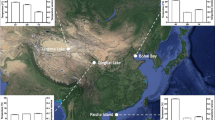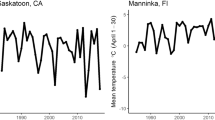Abstract
Timing of reproduction and clutch size are important determinants of breeding success, especially in seasonal environments. Several recent bird population studies have shown changes in breeding time and in natural selection on it. These changes have often been linked with climate change, but few studies have investigated how the traits or natural selection are actually connected with climatic factors. Furthermore, the effect of population density on selection has been rarely considered, despite the potential importance of density in demographic processes. We studied variation in natural selection on laying date and on clutch size in relation to measures of spring phenology and population density in a long-term study of pied flycatchers in SW Finland. The phenological stage of the environment at mean egg-laying did not affect the direction of selection on either laying date or on clutch size. There was, however, stronger selection for earlier laying date when the breeding density of the population was high, suggesting that early breeding is not necessarily beneficial as such, but that its importance is emphasized when high population density increases competition. In addition, early breeding was favoured when the pre-breeding period was cool, which may indicate an increased advantage for the fittest individuals in harsher conditions. In the middle of the twentieth century, there was selection for large clutch size, which subsequently ceased, along with an overall decrease in recruit production. Our results indicate that attention should be paid to demographic factors such as breeding density when studying natural selection and temporal changes in it.


Similar content being viewed by others
References
Ahola M, Laaksonen T, Sippola K, Eeva T, Rainio K, Lehikoinen E (2004) Variation in climate warming along the migration route uncouples arrival and breeding dates. Glob Change Biol 10:1610–1617. doi:10.1111/j.1365-2486.2004.00823.x
Ahola M, Laaksonen T, Eeva T, Lehikoinen E (2007) Climate change can alter competitive relationships between resident and migratory birds. J Anim Ecol 76:1045–1052. doi:10.1111/j.1365-2656.2007.01294.x
Ahola MP, Laaksonen T, Eeva T, Lehikoinen E (2009) Great tits lay increasingly smaller clutches than selected for—a study of climate- and density-related changes in reproductive traits. J Anim Ecol 78:1298–1306. doi:10.1111/j.1365-2656.2009.01596.x
Both C (1998) Density dependence of clutch size: habitat heterogeneity or individual adjustment? J Anim Ecol 67:659–666
Both C (2000) Density dependence of avian clutch size in resident and migrant species: is there a constraint on the predictability of competitor density? J Avian Biol 31:412–417
Both C, Visser ME (2001) Adjustment to climate change is constrained by arrival date in a long-distance migrant bird. Nature 411:296–298
Both C, Artemyev AV, Blaauw B, Cowie RJ, Dekhuijzen AJ, Eeva T, Enemar A, Gustafsson L, Ivankina EV, Järvinen A, Metcalfe NB, Nyholm NEI, Potti J, Ravussin P-A, Sanz JJ, Silverin B, Slater FM, Sokolov LV, Török J, Winkel W, Wright J, Zang H, Visser ME (2004) Large-scale geographical variation confirms that climate change causes birds to lay earlier. Proc R Soc Lond B 271:1657–1662. doi:10.1098/rspb.2004.2770
Both C, Bouwhuis S, Lessells CM, Visser ME (2006) Climate change and population declines in a long-distance migratory bird. Nature 441:81–83. doi:10.1038/nature04539
Boyce MS (1984) Restitution of r- and K-selection as a model of density-dependent natural selection. Annu Rev Ecol Syst 15:427–447
Charmantier A, Perrins CM, McCleery RH, Sheldon BC (2006) Evolutionary response to selection on clutch size in a long-term study of the mute swan. Am Nat 167:453–465
Charmantier A, McCleery RH, Cole LR, Perrins C, Kruuk LEB, Sheldon BC (2008) Adaptive phenotypic plasticity in response to climate change in a wild bird population. Science 320:800–803. doi:10.1126/science.1157174
Crick HQP, Gibbons DW, Magrath RD (1993) Seasonal changes in clutch size in British birds. J Anim Ecol 62:263–273
Crick HQP, Dudley C, Glue DE, Thomson DL (1997) UK birds are laying eggs earlier. Nature 388:526
Daan S, Dijkstra C, Tinbergen JM (1990) Family planning in the kestrel (Falco tinnunculus): the ultimate control of covariation of laying date and clutch size. Behaviour 114:83–116
Dhondt AA, Kempenaers B, Adriaensen F (1992) Density-dependent clutch size caused by habitat heterogeneity. J Anim Ecol 61:643–648
Dunn P (2004) Breeding dates and reproductive performance. Adv Ecol Res 35:69–87. doi:10.1016/S0065-2504(04)35004-X
Eeva T, Lehikoinen E, Pohjalainen T (1997) Pollution-related variation in food supply and breeding success in two hole-nesting passerines. Ecology 78:1120–1131
Eeva T, Ryömä M, Riihimäki J (2005) Pollution-related changes in diets of two insectivorous passerines. Oecologia 145:629–639. doi:10.1007/s00442-005-0145-x
Falconer DS, Mackay FTC (1996) An introduction to quantitative genetics. Longman, Harlow
Garamszegi LZ, Török J, Tóth L, Michl G (2004) Effect of timing and female quality on clutch size in the Collared Flycatcher Ficedula albicollis. Bird Study 51:270–277
Gienapp P, Postma E, Visser ME (2006) Why breeding time has not responded to selection for earlier breeding in a songbird population. Evolution 60:2381–2388
Gienapp P, Teplitsky C, Alho JS, Mills JA, Merilä J (2008) Climate change and evolution: disentangling environmental and genetic responses. Mol Ecol 17:167–178. doi:10.1111/j.1365-294X.2007.03413.x
Gladbach A, Gladbach DJ, Quillfeldt P (2010) Seasonal clutch size decline and individual variation in the timing of breeding are related to female body condition in a non-migratory species, the Upland Goose Chloephaga picta leucoptera. J Ornithol 151:817–825. doi:10.1007/s10336-010-0518-8
Goodenough AE, Elliot SL, Maitland DP, Hart AG (2009) Variation in the relationship between lay date and clutch size in three cavity-nesting woodland passerines. Acta Ornithol 44:27–36. doi:10.3161/000164509X464858
Gustafsson L (1987) Interspecific competition lowers fitness in collared flycatchers Ficedula albicollis: an experimental demonstration. Ecology 68:291–296
Häkkinen R, Linkosalo T, Hari P (1998) Effects of dormancy and environmental factors on timing of bud burst in Betula pendula. Tree Physiol 18:707–712
Jenni L, Kéry M (2003) Timing of autumn bird migration under climate change: advances in long-distance migrants, delays in short-distance migrants. Proc R Soc Lond B 270:1467–1471. doi:10.1098/rspb.2003.2394
Klomp H (1970) The determinants of clutch size in birds: a review. Ardea 58:1–125
Laaksonen T, Ahola M, Eeva T, Väisänen RA, Lehikoinen E (2006) Climate change, migratory connectivity and changes in laying date and clutch size of the pied flycatcher. Oikos 114:277–290
Lack D (1954) The natural regulation of animal numbers. Clarendon, Oxford
Lundberg A, Alatalo RV (1992) The pied flycatcher. T & AD Poyser, London
MacArthur RH (1962) Some generalized theorems of natural selection. Proc Natl Acad Sci USA 48:1893–1897
Moorcroft P, Albon SD, Pemberton JM, Stevenson IR, Clutton-Brock TH (1996) Density-dependent selection in a fluctuating ungulate population. Proc R Soc B 263:31–38
Mueller LD (1997) Theoretical and empirical examination of density-dependent selection. Annu Rev Ecol Syst 28:269–288
Newton I (1998) Population limitation in birds. Academic, London
Nilsson J-Å (1989) Causes and consequences of natal dispersal in the marsh tit, Parus palustris. J Anim Ecol 58:619–636
Przybylo R, Sheldon BC, Merilä J (2000) Climatic effects on breeding and morphology: evidence for phenotypic plasticity. J Anim Ecol 69:395–403
Rowe L, Ludwig D, Schluter D (1994) Time, condition, and seasonal decline of avian clutch size. Am Nat 143:698–722
Salewski V, Bairlein F, Leisler B (2002) Different wintering strategies of two Palearctic migrants in West Africa—a consequence of foraging strategies? Ibis 144:85–93
Sanz JJ (2003) Large-scale effect of climate change on breeding parameters of pied flycatchers in Western Europe. Ecography 26:45–50
Sanz JJ, Potti J, Moreno J, Merino S, Frías O (2003) Climate change and fitness components of a migratory bird breeding in the Mediterranean region. Glob Change Biol 9:1–12
Sheldon BC, Kruuk LEB, Merilä J (2003) Natural selection and inheritance of breeding time and clutch size in the collared flycatcher. Evolution 57:406–420
Tinbergen JM (2005) Biased estimates of fitness consequences of brood size manipulation through correlated effects on natal dispersal. J Anim Ecol 74:1112–1120. doi:10.1111/j.1365-2656.2005.01010.x
van Noordwijk AJ, McCleery RH, Perrins CM (1995) Selection for the timing of great tit breeding in relation to caterpillar growth and temperature. J Anim Ecol 64:451–458
Visser ME, van Noordwijk AJ, Tinbergen JM, Lessells CM (1998) Warmer springs lead to mistimed reproduction in great tits (Parus major). Proc R Soc Lond B 265:1867–1870
von Haartman L (1982) Two modes of clutch size determination in passerine birds. J Yamashina Inst Ornith 14:214–219
Acknowledgments
We greatly appreciate the contribution of Professor Lars von Haartman, whose lifelong interest in hole-breeding Passerines and dedication to data collection made our study possible. We thank Risto A. Väisänen and the Finnish Museum of Natural History for trusting the data to us, and a number of people who participated in field work in the Harjavalta area. Constructive comments and suggestions by Christiaan Both, Tore Slagsvold, Elina Koivisto and two anonymous reviewers improved the manuscript. A suggestion of new analysis by the other reviewer was especially helpful. Eric Le Tortorec kindly checked the language. The Finnish Meteorological Institute provided the temperature data. This study was funded by the Academy of Finland (project 8119367 to TE), the Kone Foundation (grants to MA and EL) and the Emil Aaltonen Foundation (a grant to TL). The data were collected in compliance with Finnish legislation and with appropriate permissions.
Author information
Authors and Affiliations
Corresponding author
Additional information
Communicated by Ola Olsson.
Rights and permissions
About this article
Cite this article
Ahola, M.P., Laaksonen, T., Eeva, T. et al. Selection on laying date is connected to breeding density in the pied flycatcher. Oecologia 168, 703–710 (2012). https://doi.org/10.1007/s00442-011-2135-5
Received:
Accepted:
Published:
Issue Date:
DOI: https://doi.org/10.1007/s00442-011-2135-5




